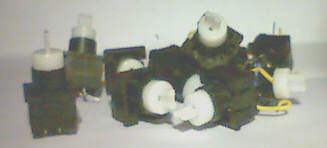Al's Robotics....
| Site
Index |
| Site Index |
| Rambo Auto Tools |
| Robotics Events |
| Linux Computing |
| Reading Books |
| Latest
News |
new information added to the Robux Project Pages click here for more info |
Sensors
Sensors play a key part in robotics without them robots would know nothing about the out side world or how to act on changes to it's environment. There are various types of sensors that can be brought at your local electronics shop or if your like me you'll want to spend as little money as possible on your robot but still have good quality sensors. One way of doing this is to make your own.
Push switches
Get hold of an old computer key board and take it apart. Inside the keyboard will be some electronics that are of no use but the main thing is the monetary switches that are in it, there should be at least 101 switches in there and maybe more.

Here is a photo of some switches that I have taken out of keyboards. And remember these are high quality switches as well, they are designed to take loads of pushes before braking (around a million infact).You can see that I have taken the keys of the switches, this is because I usually make my own leavers using some plastic.
If you look at "ARM RAM" you will see that the switches that I have used in that are the same as it the photo, and all I have done is to cut a plastic strip and drill holes in it so the switch ends can be pushed into them. This Is a very simple way of mounting the switch leavers to the switches and works well.
Opto sensors
Other sensors that are commonly used in robotics are opto sensors, these are usually infra red devices. Infra red is slightly more complicated then just connecting a switch to your Robot / processor, you need to build a circuit that can emit a 38 kHz carrier most people use a 555 CMOS timer to generate the pulse. Once this is made you will need to pick the signal up, to do this you should use a IR. transistor these tend to save on the amount of electronics needed to be made as they contain a amplification circuit built into them so they can be connected straight to your processor (if there at the right voltage).
Ultra sonic sensors
Ultra sonic works in the same way as infra red but the pulse generator needs to make a 40 kHz pulse instead. And you will have to make a amplifier circuit for it.
Sensor ideas
One sensor that I think is really important in a robot is a voltage checker so you can monitor your batteries. You can do this by using a LM339 voltage comparator IC. This IC can be set to trigger a high out and the voltage that is needed to trigger the IC is user definable. So you can set the IC to trigger say at 5V so if the voltage is higher then 5V the IC will output a high (1) if the voltage falls below the set value then the IC will cut the high output (0), which would tell your processor that the batteries are going flat.
Salvage
You will find that a good source of high grade sensors can be found in old computer equipment especially printers. Printers can contain things like infra red devices and micro switches and of course they contain lots of other stuff too that is useful to robotics like gears, DC motors, stepping motors and metal bars etc.
More to come latter, maybe some circuits.
Web pages built and © by A R Martin E-mail at:
Home-page Robots Tutorials Links E-mail Circuits Events BEAM PIC Microchip Robotics Shop Computers FMM-RobotWars Sponsors Suggested reading Ebay Listings Serial Speed Controllers MicroMouse Walkers Driller-Killer Laptops Excaliber Robot Retox Drill Robot Robot motors Robot Builder Google Robux Project gorobotics Robot Cafe Robotics Solar Navigator PIC Axe Tech Supplies MUTR GSM Control Home Automation RC tracker Qtronics Design - Electronics & Firmware Design Artist R C Martin http://www.speedace.info/qtronics.htm http://www.solarnavigator.net/qtronics.htm http://www.elecdir.com/site/store/23197/index.html http://www.robotbuilder.co.uk/forum/topic.asp?whichpage=2&TOPIC_ID=861ᶱ